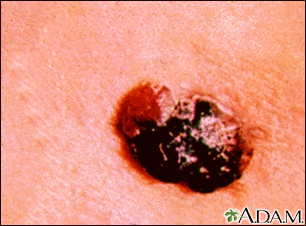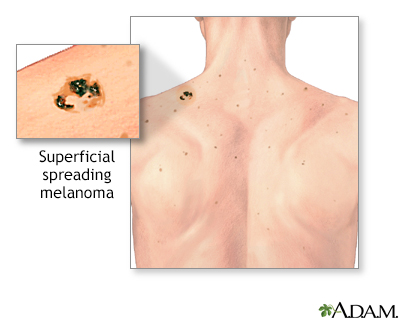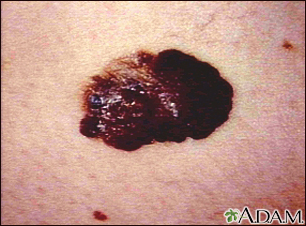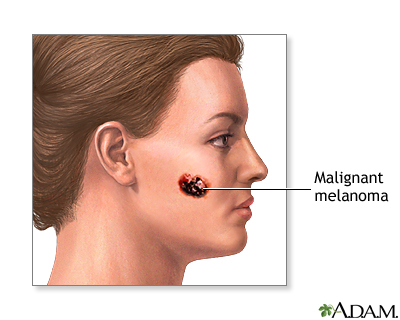Pregnancy SmartSiteTM
Skin cancer - melanoma; Malignant melanoma; Lentigo maligna melanoma; Melanoma in situ; Superficial spreading melanoma; Nodular melanoma; Acral lentiginous melanoma DefinitionMelanoma is the most dangerous type of skin cancer. It is also the rarest. It is the leading cause of death from skin disease. Other common types of skin cancer are squamous cell carcinoma and basal cell carcinoma. CausesMelanoma is caused by changes (mutations) in skin cells called melanocytes. These cells make a skin color pigment called melanin. Melanin is responsible for skin and hair color. Melanoma can appear on normal skin. Sometimes it can develop from moles. Moles that are present at birth may develop into melanomas. Larger moles that are present at birth may be at higher risk for developing melanoma. There are four major types of melanoma:
The risk for developing melanoma increases with age. However, more and more young people are developing it. You are more likely to develop melanoma if you:
Other risk factors include:
SymptomsA mole, sore, lump, or growth on the skin can be a sign of melanoma or other skin cancer. A sore or growth that bleeds, or changes in color can also be a sign of skin cancer. The ABCDE system can help you remember possible symptoms of melanoma:
Another way to look for possible melanoma is the "ugly duckling sign." This means the melanoma does not look like any of the other spots on the body. It stands out like the ugly duckling in the children's story.
Exams and TestsYour health care provider will check your skin and look at the size, shape, color, and texture of any suspicious areas with a dermatoscope. If your provider thinks you might have skin cancer, a piece of skin from the growth will be removed. This is called a skin biopsy. The sample is sent to a lab for examination under a microscope. A sentinel lymph node (SLN) biopsy may be done in some people with melanoma to see if the cancer has spread to nearby lymph nodes. Once melanoma has been diagnosed, CT scans or other types of x-rays may be done to see if the cancer has spread. TreatmentSurgery is almost always needed to treat melanoma. The skin cancer and some surrounding area will be removed. How much skin is removed depends on how deep the melanoma has grown. If the cancer has spread to nearby lymph nodes, these lymph nodes may also be removed. After surgery, depending on the risk of the disease returning, you may receive chemotherapy or immunotherapy. Treatment is more difficult when the melanoma has spread to other organs. Treatment involves shrinking the skin cancer and treating the cancer in other areas of the body. You may receive:
If you have melanoma that is hard to treat, you might consider enrolling in a clinical trial. Ask your provider for more information. Researchers continue to study new treatments. Support GroupsSharing with others who have common experiences and problems can help you not feel alone. More information and support for people with melanoma and their families can be found at:
Outlook (Prognosis)How well you do depends on many things, including how early the cancer was diagnosed, and how far it has spread. In its early stage, most melanomas can be cured by surgery. Melanoma that is very deep or has spread to the lymph nodes is more likely to return after treatment. If it is deeper than 4 mm or has spread to the lymph nodes, the cancer is more likely to have spread to other tissues and organs. If you have had melanoma and recovered, it is very important to examine your body regularly for any unusual changes. Your risk for melanoma increases once you have had this cancer. Melanoma can return years later. Possible ComplicationsMelanoma can spread to other parts of the body. Melanoma treatment can cause side effects, including pain, nausea, and fatigue. When to Contact a Medical ProfessionalContact your provider if you notice a new growth or any other changes in your skin. Also talk to your provider if an existing spot:
PreventionSome people should see a skin specialist (dermatologist) for regular skin exams. These include people with:
A skin specialist can examine you and tell you whether you need regular skin checks. Sometimes, unusual moles are removed to prevent them from turning into melanoma. You should also examine your own skin once a month. Use a mirror to check hard-to-see places. Use the ABCDE system and the "ugly duckling" sign when checking your skin. The best way to prevent skin cancer is to reduce your exposure to sunlight. Ultraviolet light is most intense between 10 a.m. and 4 p.m. Try to avoid sun exposure during these hours. Protect your skin by wearing a hat, long-sleeved shirt, long skirt, or pants when you have to be outside. The following tips can also help:
Other important facts to help you avoid too much sun exposure:
Even though melanoma can develop in some moles, dermatologists feel that there is no advantage to remove moles to prevent melanoma. ReferencesNational Cancer Institute website. Melanoma treatment (PDQ) health professional version. www.cancer.gov/types/skin/hp/melanoma-treatment-pdq. Updated April 16, 2024. Accessed April 22, 2024. National Comprehensive Cancer Network website. NCCN clinical practice guidelines in oncology: melanoma: cutaneous version 2. 2024. www.nccn.org/professionals/physician_gls/pdf/cutaneous_melanoma.pdf. Updated April 3, 2024. Accessed April 22, 2024. North JP, Bastian BC, Lazar AJ. Melanoma. In: Calonje E, Bren T, Lazar AJ, Billings SD, eds. McKee's Pathology of the Skin. 5th ed. Philadelphia, PA: Elsevier; 2020:chap 26. Zaba LC, Wang JY, Swetter SM. Melanoma. In: Bolognia JL, Schaffer JV, Cerroni L, eds. Dermatology. 5th ed. Philadelphia, PA: Elsevier; 2024:chap 113. | ||
| ||
Review Date: 2/15/2024 Reviewed By: Elika Hoss, MD, Assistant Professor of Dermatology, Mayo Clinic, Scottsdale, AZ. Also reviewed by David C. Dugdale, MD, Medical Director, Brenda Conaway, Editorial Director, and the A.D.A.M. Editorial team. View References The information provided herein should not be used during any medical emergency or for the diagnosis or treatment of any medical condition. A licensed medical professional should be consulted for diagnosis and treatment of any and all medical conditions. Links to other sites are provided for information only -- they do not constitute endorsements of those other sites. No warranty of any kind, either expressed or implied, is made as to the accuracy, reliability, timeliness, or correctness of any translations made by a third-party service of the information provided herein into any other language. © 1997- A.D.A.M., a business unit of Ebix, Inc. Any duplication or distribution of the information contained herein is strictly prohibited. | ||


 Melanoma of the li...
Melanoma of the li... Skin cancer - mali...
Skin cancer - mali... Skin cancer - rais...
Skin cancer - rais... Skin cancer, melan...
Skin cancer, melan... Skin cancer, melan...
Skin cancer, melan... Skin cancer, close...
Skin cancer, close... Skin cancer - mela...
Skin cancer - mela... Melanoma
Melanoma Skin cancer, melan...
Skin cancer, melan... Malignant melanoma
Malignant melanoma
